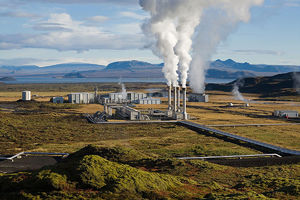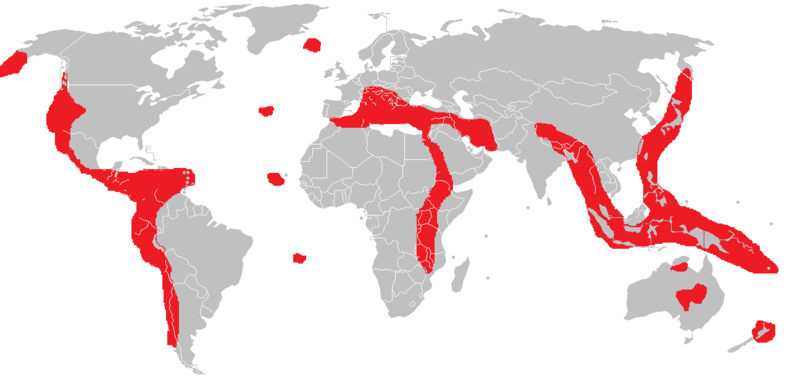Geothermal electricity

Geothermal electricity is electricity generated by the use of geothermal energy. Not all countries can accomplish this efficiently, as the temperatures beneath the surface of the Earth vary from place to place. Countries located on geothermal hotspots, shown in Figure 2, have the benefit of high temperatures near the surface resulting in a higher thermal efficiency of heat transfer.[2]
The thermal energy beneath the surface of the Earth naturally produces steam - which can escape in geysers. This steam can be used to spin a turbine connected to a generator, thereby producing electricity. These natural steam systems are fairly rare however, so it is more common to use a system consisting of liquid water, which converts to steam as it approaches the surface.
Worldwide Production
Worldwide as of 2015 there are 24 countries (visible in Figure 3) currently producing 12.8 GWe (12.8 billion watts) of electricity, with a growth rate of 5% from 2012 to 2015. Global power capacity is expected to reach 14.5 - 17.6 GWe by 2020.[3] The current power capacity from geothermal is only estimated to be at 6.5% of its potential, meaning that another 200 GWe or more could be used in the future.
Along with coming from a renewable energy source, geothermal electricity also comes along with relatively low carbon dioxide emissions in electricity production: 45 grams of CO2 are emitted per kilowatt-hour, which is less than 5% of the CO2 emitted by a typical coal-fired power plant, and about 10% that of natural gas power plants.[4]
Geothermal electricity plants can also be used for cogeneration - heating houses with excess energy.


References
- ↑ Wikimedia Commons [Online], Available: https://commons.wikimedia.org/wiki/File:NesjavellirPowerPlant_edit2.jpg#/media/File:NesjavellirPowerPlant_edit2.jpg
- ↑ R. Wolfson, "The Geothermal Resource" in Energy, Environment, and Climate, 2nd ed., New York, NY: W.W. Norton & Company, 2012, ch. 8, pp. 204-218
- ↑ Geothermal Energy Association. (August 11, 2015). The International Geothermal Market At A Glance [Online], Available: http://geo-energy.org/reports/2015/Int'lMarketataGlanceMay2015Final5_14_15.pdf
- ↑ IPCC SRREN. (August 11, 2015). pp. 982 of Methodology [Online], Available: http://geo-energy.org/reports/2015/Int'lMarketataGlanceMay2015Final5_14_15.pdf
- ↑ Adapted from: R. Wolfson, "Energy from Earth and Moon" in Energy, Environment, and Climate, 2nd ed., New York, NY: W.W. Norton & Company, 2012, ch. 8, pp. 204-224
- ↑ Information from R. Bertani, Geothermal Power Generation in the World 2010-2014 Update Report [Online], Available: https://pangea.stanford.edu/ERE/db/WGC/papers/WGC/2015/01001.pdf

